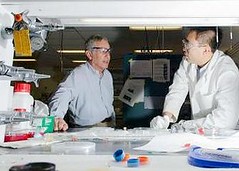太陽能再突破 美科學家找到「人工葉子」最後拼圖
Category: 水新聞 Created: Wednesday, 08 April 2015 05:00 受到植物光合作用的啟發,加州理工學院開發出一種導電氧化鎳薄膜,可以將光線轉換成裂解水,安全地製造出氫燃料。
受到植物光合作用的啟發,加州理工學院開發出一種導電氧化鎳薄膜,可以將光線轉換成裂解水,安全地製造出氫燃料。
植物的光合作用機制將陽光、水和二氧化碳轉換成氧和碳水化合物。人工光合作用系統則複製這樣的機制。
用氧化鎳薄膜作為矽等半導體材料的保護膜,能改善甲烷、氫等太陽能燃料的製造過程。
「這種新薄膜可以讓太陽能燃料的製造過程更有效率、穩定、安全,不會產生容易爆炸的氫氧混和物。」研究作者、加州理工學院化學系特聘教授Nate Lewis說。
氧化鎳薄膜讓人工光合作用系統──又叫太陽能燃料發電機或「人工葉子」──的發展,往前邁進一大步。
找到合適材料 人工葉子有譜了
Lewis團隊開發的人工光合作用系統有3個主要元件:兩個電極、光電陽極和光電陰極、一個塑膠膜。
光電陽極利用陽光氧化水分子,產生氧氣,質子和電子,光電陰極則重新結合質子和電子,形成氫氣;而塑膠膜將兩種氣體隔開,避免產生爆炸,並在壓力下收集氣體,使之安全地進入導管。
但過去類似的嘗試都因為不同原因失敗了。
「薄膜的條件非常嚴苛,必須與其保護的半導體相容、不透水、可導電、高透光度,以及具有高度催化性,以產生氧氣和燃料。達成以上任何一個條件都是一種突破,但我們選用的材料具備所有條件。」Lewis說。
研究團隊發現,氧化鎳薄膜可和許多半導體材料相容,包括矽、磷化銦和碲化鎘。當應用於光電陰極,氧化鎳薄膜的效能就可超越過去嘗試的其他材料。
要量產 還有段距離
不過Lewis也強調,人工光合作用技術距離量產還很遙遠,光電陰極等元件也還有進步空間。
「我們的團隊同時也在開發新的光電陰極,試著將這些元件結合在一起形成可運作的系統。這不容易,但我們已經找到過去半個世紀所找不到的拼圖。」Lewis說。
這篇研究「以透明催化氧化鎳薄膜包覆之光電極進行太陽能驅動氧化」於3月9日發表於當周國家科學院院刊線上版。
Inspired by a chemical process found in leaves, researchers at the California Institute of Technology have developed an electrically conductive film that could lead to devices that harness sunlight to split water (H2O), safely creating hydrogen fuel.
When applied to semiconducting materials such as silicon, the nickel oxide film facilitates an important chemical process in the solar-driven production of fuels such as methane or hydrogen.
“We have developed a new type of protective coating that enables a key process in the solar-driven production of fuels to be performed with record efficiency, stability, and effectiveness, and in a system that is intrinsically safe and does not produce explosive mixtures of hydrogen and oxygen,” says Nate Lewis, a distinguished professor of chemistry at Caltech and coauthor of a new study that describes the film.
The development could lead to safe, efficient artificial photosynthetic systems – also called solar-fuel generators or “artificial leaves.”
Such a system would replicate the natural process of photosynthesis that plants use to convert sunlight, water, and carbon dioxide into oxygen and fuel in the form of carbohydrates, or sugars.
The artificial leaf that Lewis’ team is developing in part at Caltech’s Joint Center for Artificial Photosynthesis (JCAP) consists of three main components: two electrodes – a photoanode and a photocathode – and a plastic membrane.
The photoanode uses sunlight to oxidize water molecules to generate oxygen gas, protons, and electrons, while the photocathode recombines the protons and electrons to form hydrogen gas.
The membrane keeps the two gases separate to eliminate any possibility of an explosion, and lets the gas be collected under pressure to safely push it into a pipeline.
All previous attempts have failed for various reasons.
“You want the coating to be many things: chemically compatible with the semiconductor it’s trying to protect, impermeable to water, electrically conductive, highly transparent to incoming light, and highly catalytic for the reaction to make oxygen and fuels,” says Lewis, who is also JCAP’s scientific director.
“Creating a protective layer that displayed any one of these attributes would be a significant leap forward, but what we’ve now discovered is a material that can do all of these things at once,” he said.
The team has shown that its nickel oxide film is compatible with many different kinds of semiconductor materials, including silicon, indium phosphide, and cadmium telluride.
When applied to photoanodes, the nickel oxide film exceeded the performance of other similar films – including one that Lewis’s group created just last year.
Lewis cautions that scientists are still far from developing a commercial product that can convert sunlight into fuel. Other components of the system, such as the photocathode, also need to be perfected.
“Our team is also working on a photocathode,” Lewis says. “What we have to do is combine both of these elements together and show that the entire system works. That will not be easy, but we now have one of the missing key pieces that has eluded the field for the past half-century.”
The study, “Stable solar-driven oxidation of water by semiconducting photoanodes protected by transparent catalytic nickel oxide films,” was published the week of March 9 in the online issue of the journal “The Proceedings of the National Academy of Sciences.”
※ 全文及圖片詳見:ENS
Powered by Versicherungsvergleich








